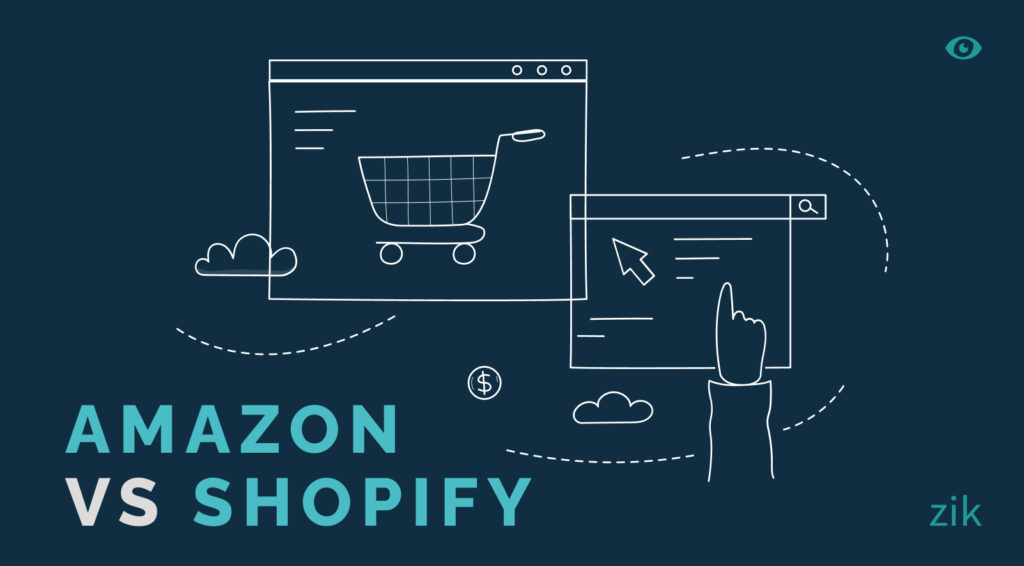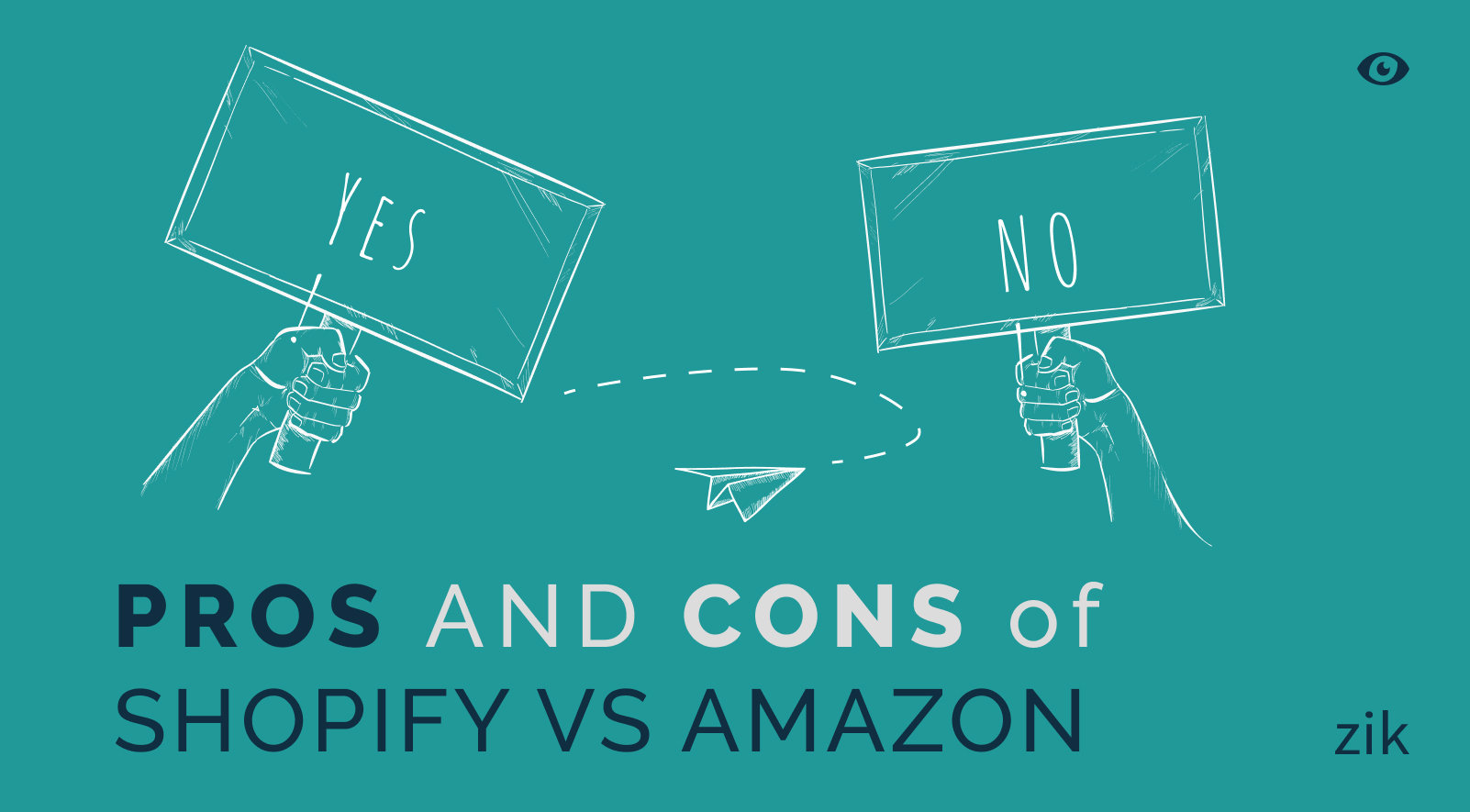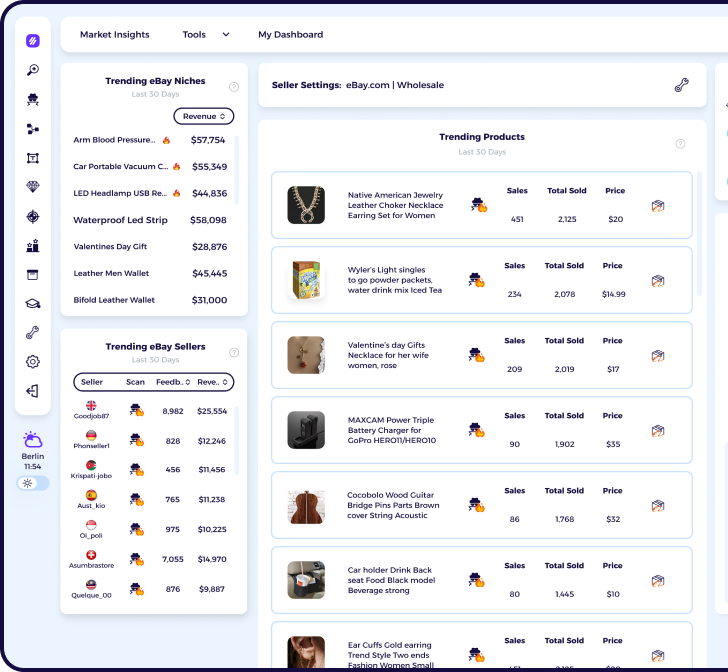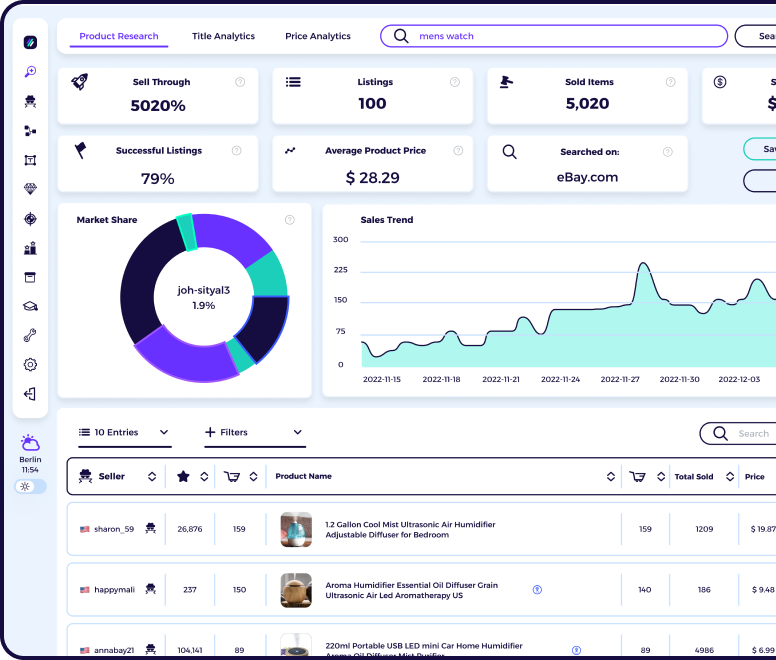With the rise of eCommerce sales worldwide, there is also an increase in the number of eCommerce businesses. In launching your eCommerce business, you will need to choose an eCommerce platform.
Shopify and Amazon are two of the largest eCommerce platforms, and although their functionalities differ, they are two of the most common eCommerce platforms in the world. In this post, we will review these platforms based on their pricing, themes and designs, customization, and customer support.
Let’s get started!
What is The Main Difference Between Amazon and Shopify?
In starting your online business, you have to make a choice of the eCommerce platform you will use. At the moment, Shopify and Amazon are the most common options hence you may have to choose between either platform.
However, what is the main difference between Amazon and Shopify?
Shopify is an online store builder, while Amazon is an online marketplace with millions of consumers. Just like Walmart is a retail outlet that sells goods from different manufacturers, Amazon is an eCommerce marketplace where sellers can reach millions of customers.
Shopify on the other hand can be likened to shopping malls where retailers can set up their stores. Basically, while Shopify provides you with the tools needed to set up your online store including web hosting, Amazon allows you to display your items on their “shelf”.
Amazon Overview
Amazon is the largest eCommerce retail company in the United States with the Amazon app garnering about 98 million users monthly in the US. It is an online marketplace that gives online merchants access to a customer base of over 197 million customers.
By using Amazon, sellers can enjoy the Amazon FBA (Fulfillment by Amazon) program that helps sellers store inventory, and handle packaging and shipping of customer orders.
Amazon offers many benefits to sellers with small inventories, such as not having to build a standalone store and access to a large customer base. They can also help you deal with the logistic requirements of your business.
Shopify Overview
Shopify operates using a different business model from Amazon. It is an eCommerce platform that serves as an online store builder. Essentially, Shopify is a Content Management System (CMS) just like WordPress, however, it is streamlined toward eCommerce businesses.
Users can choose from over 80 professionally designed themes that they can customize to their fit. Shopify offers a variety of tools to help merchants manage their businesses, including marketing and store management, analytics, social media integrations, and third-party integrations.
Other eCommerce tools such as gift cards and discount management, customer information storage, and connection with fulfillment centers are also available on Shopify. Apart from allowing third-party payment platforms, there is also Shopify Payments which is a built-in payment processor for your Shopify store, it is powered by Stripe. All these features contribute to making Shopify a perfect website builder for eCommerce businesses.
Apart from the basic service plans available for individual sellers, Shopify also features plans for large corporations. A number of companies have built online stores using Shopify, including Heinz, Bombas, and Staples.
Shopify vs Amazon Features Comparison
Pricing
Shopify Pricing
There are 3 pricing plans on Shopify which are:
– Basic plan at $29/month. This plan features basic reports, 2 staff accounts, up to 4 inventory locations, and up to 77% discount on shipping.
– Shopify plan at $79/month. This plan features professional reports, 5 staff accounts, up to 5 inventory locations, and up to 88% shipping discount.
– Advanced plan at $299/month. This plan features a custom report builder, 15 staff accounts, up to 8 inventory locations, and up to 88% shipping discount.
All the pricing plans also feature an online store, sales channel, Shopify’s all-in-one POS system, and 24/7 support from Shopify.
Shopify also offers 7 days free trial plus a 50% discount for new stores in the US and Canada that do a yearly subscription for either the Basic, Shopify, or Advanced plans.
Amazon Pricing
There are two pricing plans on Amazon namely:
– Individual Sellers which costs $0.99 for every item sold. This plan only lets you add new products to the Amazon catalog, and it allows sellers to use Fulfillment by Amazon.
Amazon recommends this plan for sellers who will sell less than 40 units per month and sellers who have not decided what to sell. If you don’t plan to advertise or use advanced tools on Amazon, you can also settle for this plan.
– Professional Sellers costs $39/month irrespective of the number of items to be sold. Apart from using Amazon FBA, other features of this plan include inventory management with reports and spreadsheets from Amazon.
The plan also includes the ability to set your shipping fee for non-media products, and API integration.
Apart from the selling fees, there are other cost implications of using Amazon. For example, using Amazon FBA comes with its own cost which you can get here. There are also referral fees that come with using Amazon.
Themes and Design
Shopify
There are about 81 design themes online sellers can choose from for their standalone online store. 10 of them are free, and 71 are paid themes.
Users can personalize these theme to create a unique brand image. There is a theme preview in the theme editor, and a toolbar where you can add, remove items, and change settings. Apart from using the theme editor, you can also edit your theme using Liquid-Shopify’s Templating Language which interacts with HTML, CSS, and Javascript.
Essentially, Shopify themes are easily customizable to fit the demands of the customer.
Amazon
Unlike with Shopify, sellers don’t have control over the design of their own online store on Amazon. All the seller pages on Amazon are designed in a similar way.
There are three templates on the product detail page. You can upload content and images, but you cannot upload a new design.
Customer Support
Shopify
Shopify provides top-notch customer support. The Shopify forum is where Shopify-vetted experts and users help each other out with documents and video tutorials. While the Shopify changelog contains the latest information about Shopify updates.
There is the Shopify Help Center where you can receive 24/7 support either through email, chat or phone. The support team responds to queries within minutes.
Amazon
Amazon has excellent customer support. They have customer support agents that provide 24/7 support via email, live chat, and phone.
They also have a live forum where users post queries and get support from other users. There is also a help center in the forum where you can find answers to some of the most frequently asked questions.
Ease of Use
Shopify
Shopify is a drag-and-drop website builder, hence it is quite easy to use. You don’t require any special coding skills to set up an online store on Shopify.
After setting up your Shopify account, you can set up your store by simply modifying the themes on Shopify. With drag-and-drop, you can modify the colours, text, layouts, and add media elements on the page.
The user interface of Shopify is made very navigable and intuitive to aid the designing of your store-front. The back-end dashboard of Shopify is easy to navigate with everything you need on the left sidebar.
Amazon
Amazon is rated highly for ease of use. After registering on Amazon, all it takes to set up the store is to follow the stages. After setting up on Amazon, simply upload the product information which includes category, details and description.
Amazon is easy to use, such that even the fulfillment of orders requires you to simply register on FBA, and it will be sorted out.
With respect to ease of use, Amazon will be rated higher than Shopify because irrespective of how easy it is to set up a Shopify store, the variety of tools and features makes it quite complex unlike Amazon that is almost uncustomizable.
Shopify vs Amazon: Pros and Cons
In the Shopify vs Amazon battle, we will explore some of the pros and cons of each of the platform. Which solution will fit best for your eCommerce business?
Shopify Pros
-
You can build your own website easily
If you’re looking for an eCommerce platform that’s easy to use and can be customized to your needs, then Shopify is the option for you.
With this platform, you can create a website from scratch by choosing from a range of themes and using the website builder’s drag-and-drop design feature. With zero coding skills, you can easily build your own store.
-
Effective Customer Support
One of Shopify’s best qualities is their customer support. Whatever level you get stuck at while building your store, there is always help available.
Besides the 24/7 support team you can reach out to via email, live chat or call, there’s also a user forum where users and experts alike provide support for other users.
-
Multiple Payment Processor
You can receive payment on Shopify through different payment processors. Unlike some eCommerce platforms that only permit one payment option, Shopify allows third-party payment processors on their platform.
This feature allows sellers on Shopify to receive payments from almost any part of the world.
-
Varying Theme Options
Another advantage Shopify offers is the multiple theme options. There are 81 themes on Shopify, which are 81 ways of modifying your Shopify store.
These themes help your chances of converting leads into customers on your store. The better the store looks, the higher the chances of attracting customers.
Hence, if you sell media (books, video, and audio) items, there are themes that fit for such demands. If you sell non-media items, there are themes that match up to your demand. Essentially, whatever business type you run, there is something for you.
-
SEO and Marketing
Shopify makes marketing easy. It allows you to create landing pages which you can use in your marketing campaigns. To help your marketing effort, there are apps that aid marketing on the Shopify app store.
You can also customize your Shopify store such that it is search engine optimized.
Shopify Cons
-
Content marketing is not easy.
Content marketing especially blogging is not easy on Shopify. Unlike other CMS platforms, Shopify does not give the experience with blogging.
Blog editors on Shopify are not up-to-date with today’s content marketing realities. For examples, the blog layouts are inflexible, and you must always include tags in your posts.
-
No Email Hosting
One of the downsides of Shopify is the absence of email hosting. Even though they provide web hosting, you will have to create an email address for your store through a third-party email hosting service.
Amazon Pros
1. It’s a high-traffic channel
In May 2022, Amazon had about 2.4 billion visits from across the world. And with about 98 million visitors on the Amazon app in the United States alone, Amazon has a customer base you can only wish for.
One of the attractive factors for eCommerce businesses to sell on Amazon is the global customer base, which increases the chances of exposure to a wider audience.
2. new customers
Nobody visits Amazon searching for your store. But they may be searching for, and discovering, your products—products they may not have discovered otherwise, or that they may have purchased from a competitor.
Once you’ve got a customer in the door, even through a marketplace, you’ve got a chance to win repeat business through excellent service and fulfilment. This is especially the case if you’re selling products in a category that encourages frequent, repeat purchases, such as hobby supplies or fishing gear.
3. Many people prefer to shop in marketplaces.
Online marketplaces like Amazon, eBay, and Etsy have changed the way people shop for just about everything. You can get anything you want—from clothes to shoes to electronics—all on one platform, without having to go out of your way or make multiple stops along the way.
The variety and one-stop-shop aspect of a marketplace can draw in customers who prefer that kind of shopping experience.
Amazon Cons
-
A lot of competitors
Amazon is a fantastic place to sell products, but it also means there are a lot of other sellers providing the same products.
Amazon is a giant. It has millions of products for sale, and those products are available at all hours of the day. So if your product gets buried in a sea of similar offerings and isn’t getting the attention it deserves, it can be hard to get noticed.
-
Marketplace fees
Setting up shop on Amazon can boost your sales, but it comes with a price.
To start, you have to pay a marketplace fee—a percentage of each sale that is deducted from your earnings. This fee varies depending on the category of the product.
-
Lack of Control
It’s easy to see why marketplace platforms are so popular with sellers: they offer access to a large customer base, and often have an infrastructure in place to help you market and sell your products. But that convenience comes at a cost: you might be limited in your ability to brand your presence with customers, communicate with them, and dictate what items you’re able to sell.
-
Limited payment options
Amazon accepts credit and debit cards as well as transfers from your available Amazon Pay account balance. No third-party payments like PayPal are accepted.
Check out this post to take a more detailed look at the Pro’s and Con’s of selling on Amazon
Bottomline
In this post, we have explored some of the similarities and differences between Shopify and Amazon. If you plan on starting your eCommerce business, you can make a choice between Amazon and Shopify. You can also set up your own eCommerce website with Shopify and integrate it with your Amazon seller account.







